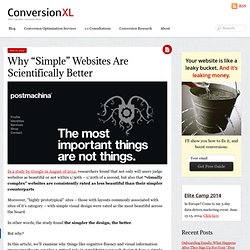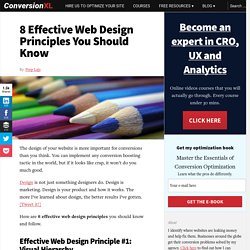

Why “Simple” Websites Are Scientifically Better. 900inShareinShare In a study by Google in August of 2012, researchers found that not only will users judge websites as beautiful or not within 1/50th – 1/20th of a second, but also that “visually complex” websites are consistently rated as less beautiful than their simpler counterparts Moreover, “highly prototypical” sites – those with layouts commonly associated with sites of it’s category – with simple visual design were rated as the most beautiful across the board.

In other words, the study found the simpler the design, the better. But why? In this article, we’ll examine why things like cognitive fluency and visual information processing theory can play a critical role in simplifying your web design & how a simple website could lead to more conversions. We’ll also look at a few case studies of sites that simplified their design, and how it improved their conversion rate, as well as give a few pointers to simplify your own design. What is a Prototypical Website? Image credit image credit. Minimal and Contrasty Color Schemes in Web Design. Making a web design with contrasty colors will allow for a better focus on certain areas of a web site.
With a minimal color scheme, more contrast can be achieved and with the right complementary color, a unique and impactful visual impression is given. Creating a web design with contrasty colors will allow for a better focus on certain areas of a web site. With a minimal color scheme, more contrast can be achieved and with the right complementary color, a unique and impactful visual impression is given. We want to show you some great and inspiring examples of minimal and contrasty color schemes in web sites where only a few colors are used with a complementary additional one (or two). Enjoy! Linda Dong FONTS of CHAOS Kettle – User-focused Design and Technology cabedge.com Jim Hoskins Benny Roth 2011 Solo Klaas Co.
Made by Vadim Syropia Eddie Diaz Design DesignWise MacMillan Lynch Phil Thompson Newsword Sylvain Toulouse Trent Walton The Big Top. Applying Visual Storytelling to Website Designs. Design Throughout history, storytelling has been an important communication tool - it’s how people connect with one another through means of entertainment, education, and even to instill moral values in one another.

While the earliest forms of storytelling were parlayed through oral communications with gestures and expressions, the landscape for storytelling has shifted with the advent of digital technologies. The role of the visual message in our communication processes has transcended mediums, not only helping people relate to a theme but allowing us as designers to intertwine content in presentation. In our quest to create the perfect design, we often analyze components like style, layout, mark-up, usability, and the flow of content, that it’s easy to overlook a key element of design: storytelling.
How do we relate storytelling into a web design? Creating a Tale Online "In every culture all around the world, storytelling is how people connect with one another. Image credit: marcwathieu. 8 Universal Web Design Principles You Should Know. The design of your website is more important for conversions than you think.

You can implement any conversion boosting tactic in the world, but if it looks like crap, it won’t do you much good. Design is not just something designers do. Design is marketing. Design is your product and how it works. The more I’ve learned about design, the better results I’ve gotten. Here are 8 effective web design principles you should know and follow.
Effective Web Design Principle #1: Visual Hierarchy Squeaky wheels get the grease and prominent visuals get the attention. Exercise. Without knowing ANYTHING about these circles, you were easily able to rank them. Certain parts of your website are more important than others (forms, calls to action, value proposition etc), and you want those to get more attention than the less important parts. Hierarchy does not only come from size. Start with the business objective You should rank elements on your website based on your business objective. Exercise. 1. 2. 3. 12 Laws and Principles to Aid You in Your Design. Centuries of observation by men and women from all walks of life have revealed important principles of design and orderliness that tend to naturally create a positive, common human reaction.

David Hume described these as "the constant and universal principles of human nature. " While these universal design principles may not always be absolutes, understanding them can help you achieve success in a multitude of fields including communications, products, services, engineering, arts and environmental design. Products designed with appreciation for these natural principles will tend to be better received and more easily utilized by the general public. A working grasp of these guidelines can be applied to art, architecture, photography, interior design and even practical communication technology including such areas as advertising and website design.
Rules of Design That Can Work For You 1. Entities should not be multiplied beyond necessity. 2. 3. Read more: Improving Usability with Fitts’ Law.